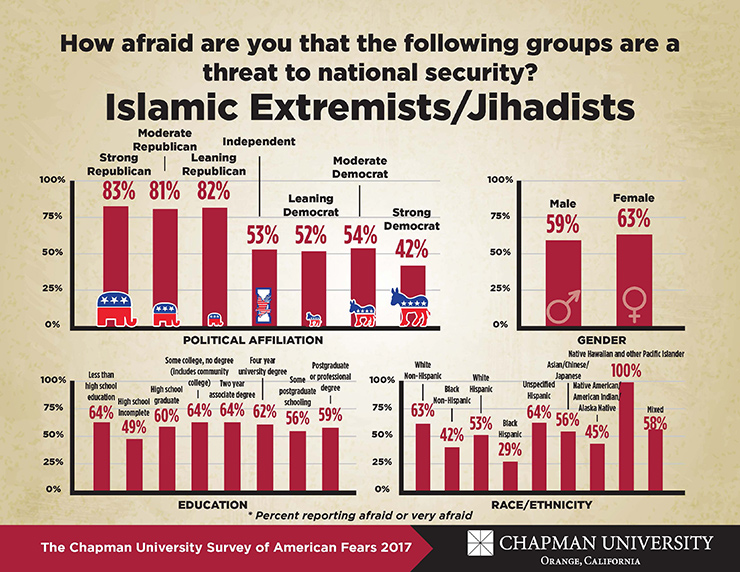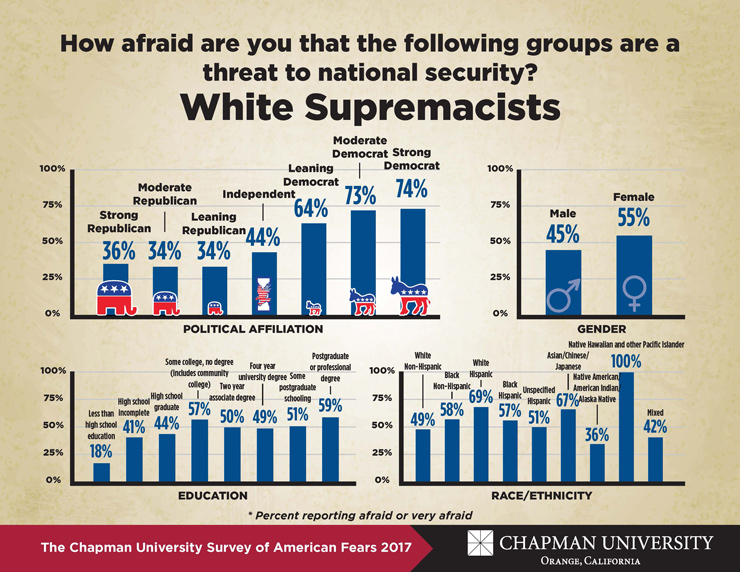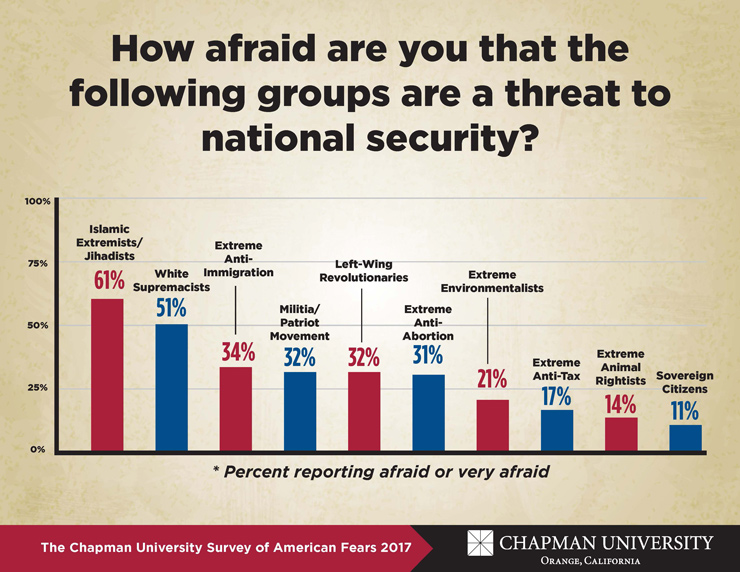Fear of Extremism and the Threat to National Security Chapman University Survey of American Fears 2017
October 11, 2017
Americans believe that both Islamic Extremists and White Supremacists represent a threat to national security. Although other types of extremist groups are a concern to large groups of Americans, only these two were identified by a majority of survey respondents. Differences between groups on which group represents the greatest threat reflects the political divisions we see in America on other issues.


Extremist Groups
In Wave 4 of the Chapman University Survey of American Fears, Americans were asked “How afraid are you that the following groups are a threat to national security?” We focused on ten types of extremist groups that have been associated with violence or the threat of violence on American soil. The ten types of extremist groups and the percentage of Americans who reported they were very afraid or afraid are:
Percent Reporting Very Afraid or Afraid to
“How afraid are you that the following groups are a threat to national security?”
| Groups | Percent of Americans |
| Islamic Extremists/Jihadists | 61% |
| White Supremacists | 51% |
| Extreme Anti-Immigration | 34% |
| Militia/Patriot Movement | 32% |
| Left-Wing Revolutionaries | 32% |
| Extreme Anti-Abortion | 31% |
| Extreme Environmentalists | 21% |
| Extreme Anti-Tax | 17% |
| Extreme Animal Rightists | 14% |
| Sovereign Citizens | 11% |
Fear of specific groups is influenced by knowledge of them, of course, in turn reflecting media effects. In the table below, we list the percent of Americans who responded that they had never heard of these groups. Although the trend isn’t perfect, as a general rule, Americans are more afraid of extremist groups that have been discussed in the media.
Percent Reporting They had Never Heard of These Groups:
| Group | Percent of Americans |
| Islamic Extremists/Jihadists | 3% |
| White Supremacists | 2% |
| Extreme Anti-Immigration | 12% |
| Militia/Patriot Movement | 15% |
| Left-Wing Revolutionaries | 18% |
| Extreme Anti-Abortion | 7% |
| Extreme Environmentalists | 8% |
| Extreme Anti-Tax | 26% |
| Extreme Animal Rightists | 9% |
| Sovereign Citizens | 36% |
Three out of five Americans report they are very afraid or afraid that Islamic Extremists/Jihadists are a threat to national security. After Islamic Extremists/Jihadists, White Supremacists are the only group that a majority of Americans view as a threat to national security (51%). Roughly one-third of Americans identify the following four as threats: Extreme Anti-Immigration groups, the Militia/Patriot Movement, Left-Wing Revolutionaries, and Extreme Anti-Abortion groups. One in five Americans is afraid Extreme Environmentalists are a threat.
Who Worries about Whom?
Although a majority of Americans see both Islamic Extremists and White Supremacists as threats to national security, there are group differences. Republicans are more likely to view Islamic Extremists as a threat (83% of Strong Republicans, 53% of Independents, 42% of Strong Democrats) while Democrats are more concerned with White Supremacists (36% of Strong Republicans, 44% of Independents, 74% of Democrats). Education is associated with fearing White Supremacists as a threat (only 18% of those with less than a high school education identify White Supremacists) but not Islamic Extremism. A majority of all educational groups believe Islamic Extremism is a threat. A majority of female respondents identify both groups as national security threats. And while a majority of male respondents identify Islamic Extremists as threatening, only 45% believe the same of White Supremacists. Whites are more likely to say Islamic Extremists represented a threat, non-whites are more likely to identify White Supremacists. The questions about which extremists are viewed as national security threats seem to be a proxy of sorts for the broad polarization that currently characterizes our country.
Implications
Fear of these groups stems from their association with violence and acts of terrorism. This fear affects the daily lives of Americans and even leads some to question the value of American freedom. 29% of Americans reports being very afraid or afraid of being a victim of hate crime. One-third agree or strongly agree with the statement, “In order to curb terrorism in this country, it will be necessary to give up some civil liberties.” Even more, 35%, disagree or strongly disagree with the statement, “We should preserve our freedoms even if it increases the risk of terrorism.” As has been seen before, elevated fears over national security can lead to lower support for national values.
The political and demographic differences over which groups threaten our security illustrate the different lenses with which Americans view the world, and these have important policy implications. The Department of Homeland Security is currently deciding whether to focus their countering violent extremism (CVE) initiative on a broad-based effort directed at various types of extremism or on a more narrow effort directed primarily at Islamic Extremism as has been suggested by the President. These data show that the majority of all Americans believe the threat is multi-dimensional, and a policy that addressed the concerns of all Americans, rather than those of specific groups, would focus on the broad-based approach.
Appendix: Supporting Tables Not Appearing Above
How afraid are you that the following groups are a threat to national security? – Islamic Extremists/Jihadists
| Group | Percent of Americans |
| Strong Republican | 83% |
| Moderate Republican | 81% |
| Leaning Republican | 82% |
| Independent | 53% |
| Leaning Democrat | 52% |
| Moderate Democrat | 54% |
| Strong Democrat | 42% |
How afraid are you that the following groups are a threat to national security? – Islamic Extremists/Jihadists
| Male/Female | Percent of Americans |
| Male | 59% |
| Female | 63% |
How afraid are you that the following groups are a threat to national security? – Islamic Extremists/Jihadists
| Education Level | Percent of Americans |
| Less than high school education | 64% |
| High school incomplete | 49% |
| High school graduate | 60% |
| Some college, no degree (includes community college) | 64% |
| Two year associate degree | 64% |
| Four year university degree | 62% |
| Some postgraduate schooling | 56% |
| Postgraduate or professional degree | 59% |
How afraid are you that the following groups are a threat to national security? – Islamic Extremists/Jihadists
| Race | Percent of Americans |
| White Non-Hispanic | 63% |
| Black Non-Hispanic | 42% |
| White Hispanic | 53% |
| Black Hispanic | 29% |
| Unspecified Hispanic | 64% |
| Asian/Chinese/Japanese | 56% |
| Native American/American Indian/Alaska Native | 45% |
| Native Hawaiian and other Pacific Islander | 100% |
| Mixed | 58% |
How afraid are you that the following groups are a threat to national security? – White Supremacists
| Political View | Percent of Americans |
| Strong Republican | 36% |
| Moderate Republican | 34% |
| Leaning Republican | 34% |
| Independent | 44% |
| Leaning Democrat | 64% |
| Moderate Democrat | 73% |
| Strong Democrat | 74% |
How afraid are you that the following groups are a threat to national security? – White Supremacists
| Male/Female | Percent of Americans |
| Male | 45% |
| Female | 55% |
How afraid are you that the following groups are a threat to national security? – White Supremacists
| Education Level | Percent of Americans |
| Less than high school education | 18% |
| High school incomplete | 41% |
| High school graduate | 44% |
| Some college, no degree (includes community college) | 57% |
| Two year associate degree | 50% |
| Four year university degree | 49% |
| Some postgraduate schooling | 51% |
| Postgraduate or professional degree | 59% |
How afraid are you that the following groups are a threat to national security? – White Supremacists
| Race | Percent of Americans |
| White Non-Hispanic | 49% |
| Black Non-Hispanic | 58% |
| White Hispanic | 69% |
| Black Hispanic | 57% |
| Unspecified Hispanic | 51% |
| Asian/Chinese/Japanese | 67% |
| Native American/American Indian/Alaska Native | 36% |
| Native Hawaiian and other Pacific Islander | 100% |
| Mixed | 42% |
For more information and articles, visit www.chapman.edu/fearsurvey.


